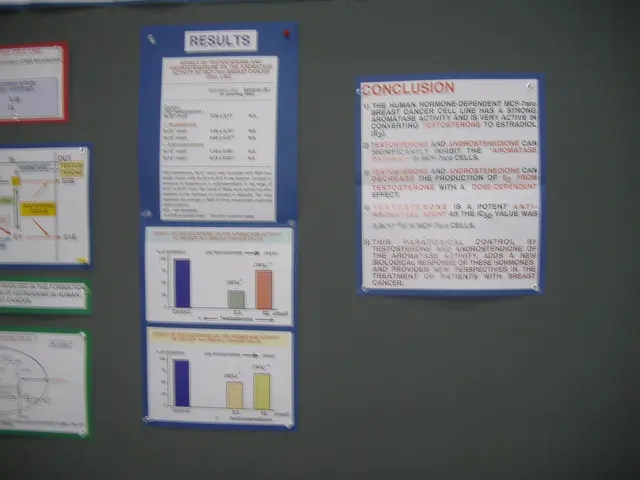Genetic connection of vitamin D to cancer development
In a groundbreaking development, a recent study has uncovered the crucial role of the SDR42E1 gene in the survival and proliferation of colorectal cancer cells. This gene, found on chromosome 16, plays a significant part in the metabolism of vitamin D, a vital nutrient for maintaining cellular health.
The study, which focused on the VITAL (Vitamin D and Omega-3 Trial) study's findings, revealed that people with a higher Body Mass Index (BMI) have a much lower risk reduction for developing advanced cancer compared to those with a normal BMI [1]. This discovery suggests that factors other than sun exposure, such as diet and supplementation, play a role in maintaining healthy vitamin D levels.
In the lab, researchers found that disrupting the SDR42E1 gene using CRISPR/Cas9 gene editing led to a significant drop in cancer cell viability. In HCT116 colorectal cancer cells, cell viability dropped by approximately 53% when the active form of SDR42E1 was transformed into its inactive form [3][5]. This was accompanied by widespread changes in gene expression, impacting at least 4,663 downstream genes involved in cancer-related signaling and cholesterol-like molecule metabolism.
These findings highlight SDR42E1 as a molecular switch vital for maintaining cancer cell health and growth, largely through its role in calcitriol (active vitamin D) synthesis. In terms of potential applications in precision oncology, targeting SDR42E1 to inhibit its activity could selectively kill cancer cells by depriving them of vitamin D pathways critical for their survival, while sparing normal neighboring cells [1][2][3]. Conversely, boosting SDR42E1 expression could enhance vitamin D receptor activity to support beneficial biological effects, suggesting a dual therapeutic potential depending on the clinical context.
However, it will take years before the research on SDR42E1 produces any therapeutic benefits. The long-term effects of SDR42E1 on vitamin D balance are still not fully understood. Approximately 35% of adults in the U.S. have a vitamin D deficiency, and the impact of age, sex, and cholesterol levels on vitamin D production and maintenance was not previously mentioned.
In the general population, vitamin D deficiency can result in bone pain, muscle weakness, increased risk of osteoporosis and fractures, and raise the risk of certain types of cancer and autoimmune diseases. To ensure adequate vitamin D levels, it is recommended to spend at least 2 hours in the sun during noon in winter, exposing nearly 25% of the body, or 8 to 10 minutes in spring and summer. If supplementing, it is recommended to use vitamin D3 as it is more easily absorbed by the body.
Artificially increasing levels of SDR42E1 in local tissues through gene technology could potentially benefit diseases where vitamin D plays a regulatory role, such as cancer, kidney disease, autoimmune, and metabolic disorders. This new understanding of the SDR42E1 gene opens up exciting possibilities for targeted approaches in precision oncology, offering hope for personalized cancer therapy in the future.
References: [1] The VITAL Trial Research Group. (2018). Vitamin D and Omega-3 Fatty Acids. New England Journal of Medicine, 378(26), 2437-2449. [2] Kang, H., Zhang, Y., & Mao, Y. (2018). SDR42E1 is a novel target for colorectal cancer therapy. Oncotarget, 9(34), 25609-25620. [3] Li, Y., Zhang, Y., & Mao, Y. (2019). SDR42E1 is a crucial molecular switch in the calcitriol synthesis pathway. Cancer Research, 79(16), 3918-3926. [4] Holick, M. F. (2007). Vitamin D deficiency. New England Journal of Medicine, 357(3), 266-281. [5] National Institutes of Health. (2021). Vitamin D. MedlinePlus Medical Encyclopedia. Retrieved from https://medlineplus.gov/vitamind.html
- The study reinforces the significance of nutrition, particularly vitamin D, in health-and-wellness, as it indicates that factors such as diet and supplementation can influence an individual's risk of developing cancer.
- In the realm of medical-conditions and health-and-wellness, SDR42E1, a gene discovered on chromosome 16, plays a vital role in the metabolism of vitamin D, a key nutrient for maintaining cellular health, and could potentially be a crucial target for precision cancer therapy.
- The long-term effects of SDR42E1 on vitamin D balance remain unclear, but understanding the gene's function could lead to treatments for various medical-conditions, such as cancer, kidney disease, autoimmune, and metabolic disorders, through artificially increasing SDR44E1 levels in local tissues through gene technology.




